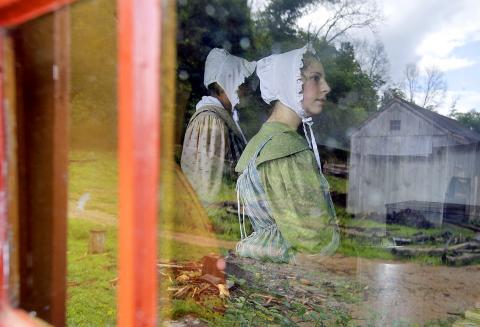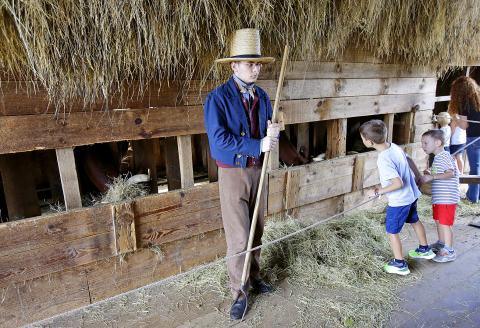A Massachusetts living history museum that depicts life in the early 19th century is looking to overhaul the way it presents the past in an effort to stay relevant to a 21st century audience.
Old Sturbridge Village has received a US$75,000 grant from the National Endowment for the Humanities it will use to partner with scholars and other consultants for a multiyear study into how it portrays four areas: agriculture and food, civics, industry and economy, and race and gender.
It’s a modest grant, but it could have a major impact.

Photo: AP
“What this grant will allow us to do is look at the entire picture and really dive deep into making sure that it’s a cohesive, purposeful experience for the visitor as they progress through the museum,” said Rhys Simmons, Old Sturbridge Village’s director of interpretation.
The reboot, the museum’s first in about 40 years, is sorely needed, Simmons said. Old Sturbridge Village hasn’t updated its staff training material since the 1970s, and visitor experience surveys have found that people, while generally positive about their visit, feel something is missing.
Many museums are dealing with similar issues, said Jeff Hardwick, deputy director of the National Endowment for the Humanities Division of Public Programs.

Photo: AP
According to a 2016 report by the American Academy of Arts and Sciences Humanities Indicators project, visits to historic sites have been on the decline since 1982.
“Many historic site interpretations have lagged behind scholarship, so they have to become more relevant to a more diverse audience,” Hardwick said.
Old Sturbridge Village, on 81 hectares in central Massachusetts, depicts life in a small New England town of the 1830s, with 40 to 50 employees dressed in period clothing going about daily routines in the home, workshops or farm and interacting with visitors. It gets about 250,000 visitors a year.
The early 19th century was a time of social upheaval, and the role of minorities and women was changing. Slavery no longer existed in most of New England, and the abolitionist and temperance movements were in full swing.
Yet the museum hasn’t done a good enough job of presenting those stories, Simmons said.
“We underrepresent the African-American and the Native American story dramatically,” Simmons said. “You leave here with the sense that it was an almost exclusively white- and male-dominated picture of what life was like.”
The role of women also needs to be re-examined, he said. While men held jobs in the fields, or in workshops, women held the household together.
“The home was the foundation of every family so women played probably the most important role in rural New England life,” Simmons said. “Men couldn’t manage without women.”
People have more options for their leisure time and money now than they did 20 years ago, and museums need to figure out how to better compete for that time and money, said Lauren McCormack, secretary of the Association for Living History, Farm and Agricultural Museums . The Old Sturbridge Village study may help.
“Anything they learn at Old Sturbridge Village hopefully would be shared throughout the field and be applicable to some extent at other museums,” said McCormack, executive director of the Marblehead Museum in Massachusetts.

June 2 to June 8 Taiwan’s woodcutters believe that if they see even one speck of red in their cooked rice, no matter how small, an accident is going to happen. Peng Chin-tian (彭錦田) swears that this has proven to be true at every stop during his decades-long career in the logging industry. Along with mining, timber harvesting was once considered the most dangerous profession in Taiwan. Not only were mishaps common during all stages of processing, it was difficult to transport the injured to get medical treatment. Many died during the arduous journey. Peng recounts some of his accidents in

“Why does Taiwan identity decline?”a group of researchers lead by University of Nevada political scientist Austin Wang (王宏恩) asked in a recent paper. After all, it is not difficult to explain the rise in Taiwanese identity after the early 1990s. But no model predicted its decline during the 2016-2018 period, they say. After testing various alternative explanations, Wang et al argue that the fall-off in Taiwanese identity during that period is related to voter hedging based on the performance of the Democratic Progressive Party (DPP). Since the DPP is perceived as the guardian of Taiwan identity, when it performs well,

The Taiwan People’s Party (TPP) on May 18 held a rally in Taichung to mark the anniversary of President William Lai’s (賴清德) inauguration on May 20. The title of the rally could be loosely translated to “May 18 recall fraudulent goods” (518退貨ㄌㄨㄚˋ!). Unlike in English, where the terms are the same, “recall” (退貨) in this context refers to product recalls due to damaged, defective or fraudulent merchandise, not the political recalls (罷免) currently dominating the headlines. I attended the rally to determine if the impression was correct that the TPP under party Chairman Huang Kuo-Chang (黃國昌) had little of a

A short walk beneath the dense Amazon canopy, the forest abruptly opens up. Fallen logs are rotting, the trees grow sparser and the temperature rises in places sunlight hits the ground. This is what 24 years of severe drought looks like in the world’s largest rainforest. But this patch of degraded forest, about the size of a soccer field, is a scientific experiment. Launched in 2000 by Brazilian and British scientists, Esecaflor — short for “Forest Drought Study Project” in Portuguese — set out to simulate a future in which the changing climate could deplete the Amazon of rainfall. It is